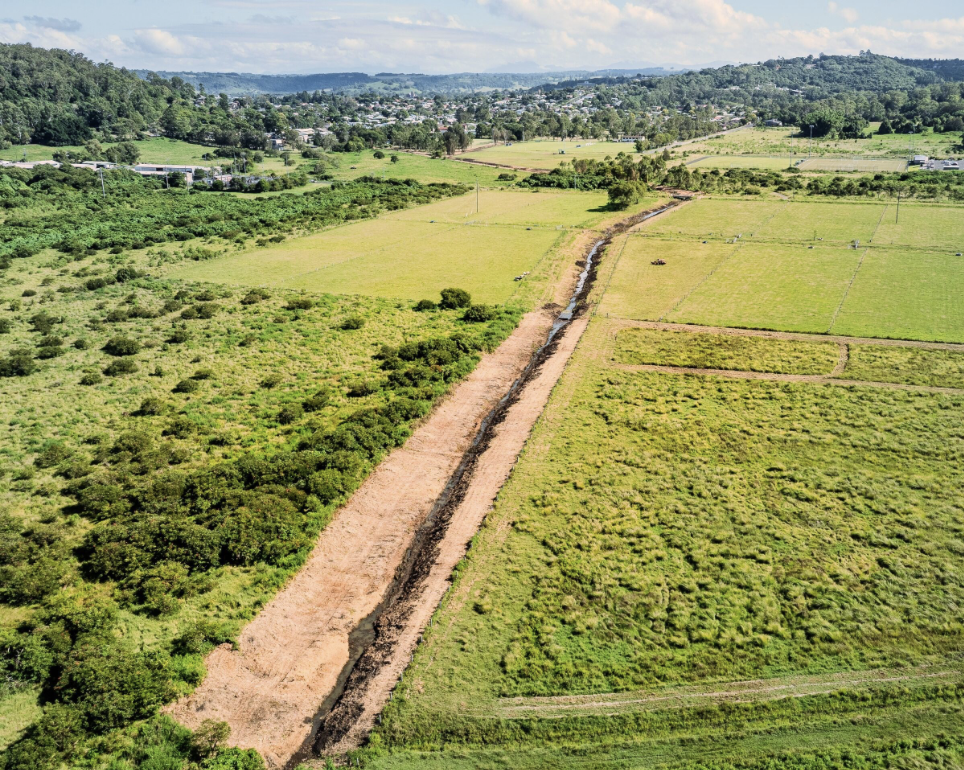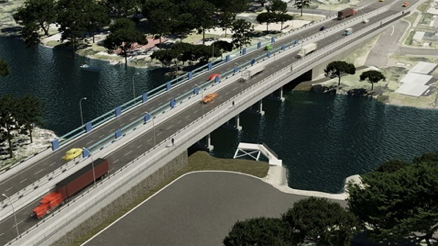$150 million NRRRP is making some progress for increased flood resilience
Simon Mumford
26 June 2025, 8:00 PM
 East Lismore drain clearing earlier this year
East Lismore drain clearing earlier this yearThe $150 million Northern Rivers Recovery and Resilience Program (NRRRP) was first announced by Senator Murray Watt in February 2023. It is funded through NEMA (National Emergency Management Agency) and delivered through the NSWRA (NSW Reconstruction Authority)
Thirty-six (36) projects across seven Northern Rivers LGA's, some 'shovel ready' were to transform Lismore and the Northern Rivers into one of the most disaster-resilient regions in NSW.
Nothing happened for the next fourteen months, with Member for Lismore Janelle Saffin saying, "We’re going in circles. Can someone please step in and take charge of this recovery so we don’t go round in circles. These projects were shovel-ready and don't need an implementation plan" in May 2023.
Two years later, some projects have been completed, and some still have a long way to go before being completed. Those are the more complex projects that require a detailed assessment, such as the Ballina bridge duplication on River Street.
Alex Wilson, Program Director with the NSWRA, told the Lismore App that there is increasing public awareness around flood risk, which is different, obviously, from physical flood risk management measures like infrastructure.
"And then we've got projects that are nature-based solutions, which also differ, then, from increasing community resilience. One of the examples of those was that we partnered with the Australian Red Cross, where they have been establishing community-led resilience teams under this program, which were put to the test and received really well during the effects of extra-tropical cyclone Alfred, including Minion and Federal, so down to the local, smaller communities," Alex said.
"It performed really well, and some of the feedback was really, really positive there."
The Red Cross approached small communities that tend to become isolated or cut off, either through power, phone reception, trees down blocking roads or water blocking roads. They work with the local community-led resilience team to develop a plan and a local contact network.
So, if there's an event like Alfred, they can meet at certain times of day at a designated building to pick up supplies, dried food for example, and use Wi-Fi, which is turned on twice a day using a Starlink (if they have one) that is run on batteries to send messages to family and friends.
Tropical Cyclone Alfred was the first time that these community-led resilience team programs were put to the test.
"I don't want to say it was a good test, but it was an opportune time for them, having gone through their training and planning, to actually put the processes into practice. It came out successfully," Alex said.
The Australian Red Cross Community-led Resilience Project (CRT) had a target of building community resilience in 70 communities across the 7 Northern NSW LGAs (note that building community resilience includes measures other than establishing a CRT). That target has been exceeded, with 88 communities reached to date.
The CRT program commenced in Tweed LGA after flooding from TC Debbie in 2017. There are 5 CRTs established (or being established) within the Lismore LGA.
If you would like to get in touch with your local CRT, email the Australian Red Cross at: NSWRESILIENCE@redcross.org.au.
The largest NRRRP project in dollar terms is the duplication of Fishery Creek Bridge on River Street and Canal Bridge on Tamarind Drive in Ballina. The cost is around $40 million, or roughly 27% of the $150 million budget. The project work has been split into a couple of different portions.

(An artists impression of the River Street bridge at Ballina)
"We've got an early works portion, which is known as pre-loading the ground. This is due to commence late July, early August, on site," Alex explained.
"The main bridge contract is currently out to market. That closes at the end of June, and so that will then be assessed and awarded as quickly as possible after that.
"When we've got an actual contractor, we'll have a better idea of timing for physically constructing the bridges. I can tell you that we've, aside from the preload that's due to start next month, Ballina Council has already been moving water mains, Telstra cables, clearing the sites, essentially for the bridges to be constructed, because we've got overhead power lines, services in the ground under the river at both locations and street lights and things. So, so they've been doing all the preparation work."
There is a loose delivery time frame for the bridge projects, but Alex didn't want to divulge the ETA until they have a builder on board and they have confidence in their deliverables.
"Their construction methodology is obviously part of the assessment, and will be reviewing the program taken. One builder might come in six months quicker than another builder, but it might be out of the budget, for example. So, there's a lot of different factors to get them to work on and assess those tenders. Once we've got firm dates, I'll happily let you know what they are."
The next most expensive projects are the Lismore pump station upgrades and the raising of two bridges at Tatham (between Casino and Coraki), which are currently underway.
Alex revealed that the nature-based solution projects will be the last to be completed as part of the $150 million NRRRP. They are slated for completion in late 2027.
"We're reforesting riparian zones along river banks. There are two projects there. One of them is caring for catchments, and our delivery partner there is the North Coast Regional Landcare Network. And then the other one is Heal the Rivers, which is through Jagun Alliance, through First Nations organisation, Jagun Alliance.
Alex said there are a number of projects within each program, so North Coast Regional Landcare Network has 35 project sites, with Jagun slightly fewer. All are spread out over the Richmond River Catchment. Their purpose is to slow the flow of water through the catchment and into the Wilsons River or Leycester Creek system.
Some of the more expensive projects on the list of the 15 completed NRRRP projects include:
- Filling in data gaps for floor-level surveys for homes and buildings. These were done by driving around in a ute with a LiDAR scanner after it was noticed that multiple councils had gaps in different locations, which they needed to complete their Flood Risk Management Plans.
- Revitalise South and East Lismore Town Drains
- Public Proposal - Lismore Flood Mitigation, Northern Rivers Resilience Initiative
- Dairy Flat road improvements
- Thearles Canal culvert upgrade
- New pump systems behind Dorothy Street, Murwillumbah
The Lismore LGA is benefiting from just over $29.4 million, or around 20% of the overall $150 million in funding.
Two of the projects within the Lismore LGA have been completed with Rouse County Council, having completed the revitalisation of the South and East Lismore town drains, which allows a clearer path for the stormwater to reach the Wilsons River.
This was tested with good effect during Tropical Cyclone Alfred.
"There were some anecdotal references there from local residents and people who haven't seen those drains working as well as they did for a very long time. Thistles Soccer Club showed up to mop their clubhouse out, and they didn't have to. Normally, in the past, that sort of size flood would have caused the club rooms to flood.
The second project to be completed was community drain clearing through Lismore City Council.
Garon Clough, Projects Director - Flood Resilience Program for Lismore City Council said, "There were locations identified from the community that had stormwater constraints, and they wanted them to be addressed. We went and targeted high-profile areas throughout the urban area to get stormwater functioning again. So it was a maintenance activity, allocation of funds to reset the function of residential drains."
There is a lot of detail to cover when looking at the rest of Lismore's five more projects, including a major rebuild of the Browns Creek Pump Station. This will be covered in a special edition on Monday morning.

